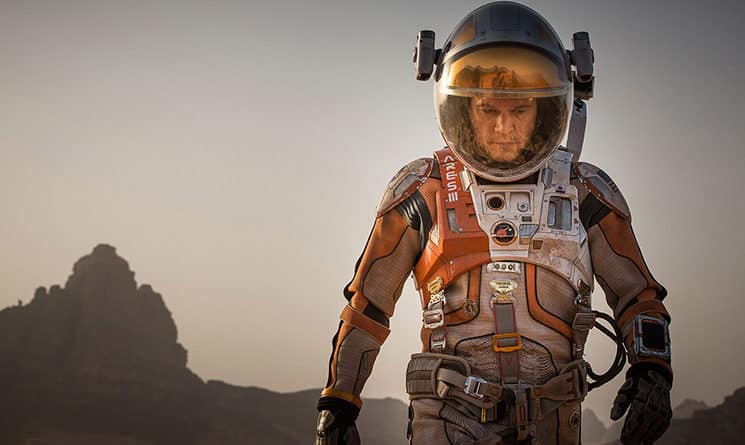You might not think that spaceflight and movie-making have much in common. But, turns out, the success of either relies heavily on planning, preparation, ingenuity, and teamwork.
It all starts with a good plan. “The Martian,” a highly technical yet remarkably human story of a manned NASA mission to Mars gone terribly awry, was originally self-published on the Web in single chapters by Andy Weir, one-time game developer and full-time NASA enthusiast. His meticulous fascination for the hard details of the math and equipment that would be involved in surviving the rigors of the lonely, desolate wasteland of outer space was a pure love letter to problem-solving in general, and NASA specifically. Science fiction for him, as it has for popular authors like Arthur C. Clark and Michael Crichton before, begins first and foremost with the science, and the fiction flows from a logical extrapolation of these parameters. If that sounds like a recipe calculated to result in cold hard boredom to you, well, you could be right, except that Weir then tosses in some remarkably likeable, interesting, and relatable personalities.
Front and center he gives us the irrepressible NASA botanist Mark Watney, a man who, when faced with complete isolation and diminishing resources while stranded alone on the surface of Mars, reacts with not only a fierce determination to figure ways to survive, but an unprecedented ability to simply laugh his way through the whole ordeal. Watney, put simply, is funny. As one-man-shows go, he makes what could have been just another “Castaway”-style slog into a rousing and engaging read. As plans for a rousing and engaging movie adaptations go, it’s a rock-solid start.
And that’s where the preparation comes in. Adapting great books into even decent movies can be a tricky procedure. Screenwriter Drew Goddard is familiar mostly as Joss Whedon’s mini-me, having written many episodes of “Buffy the Vampire Slayer” and collaborating with him to write and direct “The Cabin in the Woods.” Here, Goddard demonstrates a remarkable delicacy with preserving, even celebrating, the serious-yet-lighthearted tone of Weir’s prose. It’s a rare achievement that sets everything about the project on a path to success.
But if there’s one prevailing theme of this adventure, it’s that even the most well conceived blueprints inevitably meet unforeseen, possibly catastrophic challenges as they meet the laws of reality. Having a mind sharp enough, trained enough, and with the experience necessary to recognize these pitfalls, and to improvise effective solutions on the fly, can make or break any mission.
Hiring Ridley Scott to direct this adaptation, frankly, could be seen as something of a dice roll. His success rate as a storyteller, though featuring some of film history’s most enduring accomplishments (“Alien,” “Blade Runner”) has been variable at best (“G.I. Jane,” “Prometheus”). His visual acuity, however, and talent for composing beautiful shots is unquestionable, and he has a reputation for rising — or failing — with his writers. And here, he does exactly that. The writing is clean, honed, quick, and deep, and Scott’s camera captures it precisely. Through his lens, the stony emptiness of the dusty Martian landscape opens up into dazzling desert vistas, rich in texture and color and ever-shifting patterns of light. Complex NASA techno-babble about satellite positioning, orbital velocities, approach vectors, and resource management of establishing communication and mounting a viable rescue are illustrated in eminently understandable terms. His decision to roll with a running in-joke involving, of all things, ’70s-era disco music turns out to be a spot-on choice of fuel to keep things upbeat and, sometimes, even hilarious. His vision here is nothing less than a tour de force.
But a sound vision is only as good as the team that executes it. The cast of this movie is, well, stellar. You’re likely to recognize names like Jeff Daniels, Jessica Chastain, Kristen Wiig, Kate Mara, and Chiwetel Ejiofor (nominated for the Best Actor Oscar for his role in 2013’s “Twelve Years a Slave”) as appearing over the titles of movie posters for films they could easily carry on their own. Here, these headliners are just the supporting players, but no less at the top of their games. The nuance and gravity of their collective presence brings a palpable depth to the story on screen and provides a rich, credible background on which the central action plays out.
Which brings us to Matt Damon. Having pretty much built his career playing affable average-Joe geniuses, he simply owns the role of Mark Watney. One would think a performance as a guy completely isolated from all human contact, describing his ongoing technical struggles into video cameras (and occasionally to some very improbable space potatoes), could quickly become a maudlin and depressing affair. But Damon’s wholesome, easy-going approach is a perfect reflection of the playful attitude that made the original novel so damned accessible. The comic side of his character serves wonderfully to underscore the occasional — and authentically emotional — moments of pure despair when the tragedy of his situation does actually beat his spirit down, and drives a real sense of triumph when he rallies to keep fighting on. Damon has said that having been handed a character like Watney, the biggest challenge as an actor was simple to not “bronze the gold.”
No worries, Matt. This is pure gold. Mission accomplished.

